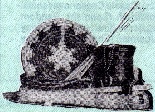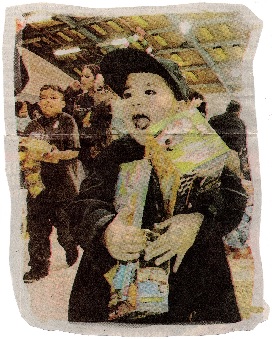|
Yá’át’ééh Marilyn Dempsey dashijní. Kiiyaa’áanii nishłí̜. Tó Dích’íi’nii báshíshchíín. Dibéłzhíní éí dashicheii. Hónágháahnii éí dashinálí. Kót’éego asdzá̜á̜ nishłí̜.

The Diné Bizaad page’s purpose is to provide an introduction to our indigenous language. Our language has been spoken by our people throughout time to communicate with one another, to sing, to pray, to express thoughts, and to think, plan, live, and reflect on our lives. Our great grandfather and leader, Chief Manuelito was quoted, “Shikéí, shidine’é, ałtah háási̜i̜łgóó… háadida léi’ nihizaad, nihisodizin, ádóone’é niidlínígíí dóó nihe’á’ál’í̜ nihił ch’aa wóle’ sha’áłchíní, hosídoolí̜i̜ji̜’, sidoołdee’ji̜’…” His words should not be forgotten and left by the wayside. So, it is up to each one of us to revitalize and maintain our dying language.
Indigenous languages have been utilized in wars of the United States. Our Diné language was used to win a war for this country. Just as the Code Talkers used our language as a weapon, we too must use our language as a weapon to protect our Diné Culture and values.
Diné Bizaad is one of the few indigenous languages left. We have not lost it all yet. Out of hundreds of indigenous languages pre-Columbus, there are less than 100 indigenous languages left that are spoken today.
Language is essential to the survival of a culture. Language and culture is essential to one’s self-identity, self-esteem, foundation, and success in life.
|
Késhmish
|
Késhmish éí Bilagáanaa bi’ó’ool’í̜í̜ł át’é. Késhmish éí Níłch’i tsoh yiził biyi’ ná’ádleeh. Éí níléí naadiin ashdla’góó yoołkááł góne’ bił náhoot’aah. Késhmish bich’i̜’ hoolzhishgo éí diné Késhmish biniiyé ach’i̜’ ádaalne’ diné nishódayoołt’eehgo yaa nidaakai łeh.
Késhmish éí Bilagáanaa baa hane’ át’é. Há̜hdá̜á̜’ shí̜í̜ éí hodiyingo awéé’ Jesus wolyéego yizhchí̜ t’áá bí bikéyahdi tó tsé’naadi áhóót’i̜i̜dgo baa hane’. Awéé’ bimá Mary wolyé jiní. Bizhé’é éí Joseph wolyé jiní. Awéé’ bi’niichí̜i̜go shí̜í̜ Mary dóó Joseph ch’ééh hooghan ła’ hainitáago diné doo haz’á̜a̜ da dabiłníigo biniinaa t’óó naaldlooshii bighan góne’ bá hoo’a’ jiní. Awéé’ naaldlooshii binás’áago bi’dizhchí̜ jiní.
|
Awéé’ bi’niichí̜i̜go shí̜í̜ níléí yá biyi’di éí so̜’ ts’ídá yéego bits’ádi’nídíín silí̜í̜’ jiní. Ákót’éego shí̜í̜ diné kéyah t’áá át’é so̜’ adinídíingo dayiiłtsá̜. Áádóó so̜’ adinídíín yé̜e̜ji̜’ ahaa neheeskai. Ła’ éí táa’go naat’áanii bikéyahdé̜é̜’ naaalyéhé deiyójáahgo dadiikai jiní. Áko diné awéé’ yílák’e da’iizla’. Awéé’ hastiin silí̜i̜’go éí naat’áanii nilí̜i̜go naháshzhiizh jiní.
Awéé’ yizchí̜i̜go diné yaa bił dahózhó̜o̜go díísh jí̜i̜di éí bééhániihgo diné ach’i̜’ é’élnééh ádaal’í̜. díísh jí̜i̜di éí Bilagáanaa béeso yee ádeił’í̜ silí̜í̜’. Áádóó Késhmish tsin dóó sin dóó Késhmish hastiin dóó bááh łikání dóó Náhooko̜s dóó ałk’ésdisí názhahí da bił ádaalyaago baa hane’ k’ad.
|
Késhmish
Christmas
|
Bi’ó’ool’í̜í̜ł – his/her/their culture
Ná’ádleeh – it happens/occurs
Bił náhoot’aah – event occurs
Ach’i̜’ ádaalne’ – gifts
Hodiyingo – in a holy/spiritual manner
Yizhchí̜ - he/she was born
Bits’ádi’nídíín – it is luminous/glowing
Dayiiłtsá̜ - they saw
|

|
Saad Bóhoo’aah
|
Fill in the blank with the missing word. Practice using Diné words every day.
|
|
Bi’ó’ool’í̜í̜ł
|
Késhmish éí Bilagáanaa __________ át’é.
(Christmas is part of the Western Culture.)
|
|
Ná’ádleeh
|
Bini’anit’á̜á̜tsoh biyi’ Na’ahóóhai __________.
(The Fair takes place in September.)
|
|
Bił náhoot’aah
|
Na’ahóóhaidi azhish __________.
(A dance takes place at the Fair.)
|
|
Ach’i̜’ ádaalne’
|
Késhmish éí __________ hóló̜.
(There are presents at Christmas.)
|
|
Hodiyingo
|
Awéé’ éí __________ yizchí̜.
(The baby is born in a spiritual manner.)
|
|
Yizhchí̜
|
Shimá éí hooghandi __________ yizchí̜.
(My mother was born at home.)
|
|
Bits’ádi’nídíín
|
So̜’ __________. (The star is luminous.)
|
|
Dayiiłtsá̜
|
Ałchíní so̜’ __________. (The children saw a star.)
|
|
